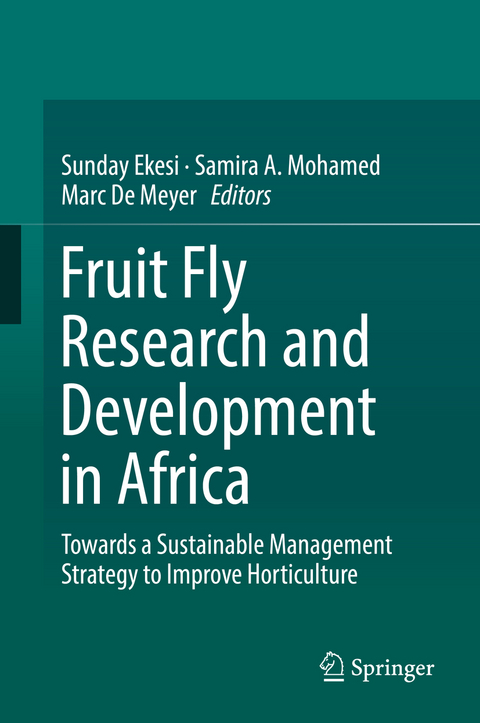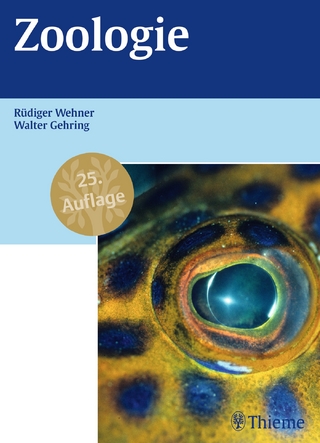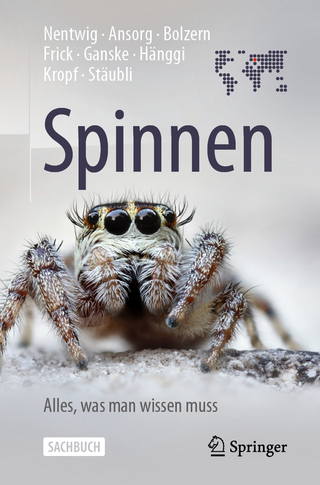
Fruit Fly Research and Development in Africa - Towards a Sustainable Management Strategy to Improve Horticulture
Springer International Publishing (Verlag)
978-3-319-43224-3 (ISBN)
Editors:S. Ekesi, S.A. Mohamed & M. De Meyer
Section A. Biology and EcologyChapter 1: Taxonomy and systematics of African fruit flies - M. De MeyerChapter 2. Identification tools for African frugivorous fruit flies (Diptera: Tephritidae) - M. VirgilioChapter 3: Population genetics of African frugivorous fruit flies (Diptera: Tephritidae): current knowledge and future perspectives - M. Virgilio and H. DelatteChapter 4: Role of microsatellite markers in molecular population genetics of fruit flies with emphasis on the Bactrocera dorsalis invasion of Africa - F. Khamis and A. MalacridaChapter 5: Fruit fly species composition, distribution and host plants with emphasis on mango-infesting species - I. Rwomushana and C. M. TangaChapter 6: Fruit fly species composition, distribution and host plants with emphasis on vegetable-infesting species - C. M. Tanga and I. RwomushanaChapter 7: Exotic invasive fruit flies (Diptera: Tephritidae): in and out of Africa - M. De Meyer and S. EkesiChapter 8: Feeding and mating behaviour of African fruit flies - A. ManrakhanChapter 9: Chemical ecology of African tephritid fruit flies - A. T. Fombong, D. Kachigamba and B. TortoChapter 10: Fruit fly nutrition, rearing and quality control - S. A. Mohamed, F. K. Khamis and C. M. TangaChapter 11: The ontological modelling of fruit fly control and management knowledge - C. C. Kiptoo, A. Gerber and A. Van der MerweSection B. Pre-harvest and Post-harvest Management MeasuresChapter 12: Detection and monitoring of fruit flies in Africa - A. ManrakhanChapter 13: Baiting and male annihilation techniques for fruit fly suppression in African - S. EkesiChapter 14: Waste brewer's yeast as an alternative source of protein for use as a bait in the management of tephritid fruit flies - S. Ekesi and C. M. TangaChapter 15: Development and application of mycoinsecticides for the management of fruit flies in Africa - N. K. Maniania and S. EkesiChapter 16: In and out of Africa: Parasitoids used for biological control of fruit flies - S. A. Mohamed, M. M. Ramadan and S. EkesiChapter 17: From behavioural studies to field application: improving biological control strategies by integrating laboratory results into field experiments - K. Merkel, V. Migani, S. Ekesi and T.S. HoffmeisterChapter 18: The use of weaver ants in the management of fruit flies in Africa - J.-F. Vayssières, J. Offenberg, A. Sinzogan, A. Adandonon, R. Wargui, F. Anato, H. Y. Houngbo, I. Ouagoussounon, L. Diamé, S. Quilici, J.-Y. Rey, G. Goergen, M. De Meyer and P. Van Mele.Chapter 19: Sterile Insect Technique (SIT) for fruit fly control - The South African experience - B. N. BarnesChapter 20: Cold and heat treatment technologies for post-harvest control of fruit flies in Africa- T. G. GroutChapter 21: Photographs of some native and exotic fruit fly species in Africa and their parasitoidsSection C. Country Specific Action Programmes and Case StudiesChapter 22: Integrated management of fruit flies - case studies from Uganda - B. E. Isabirye, C.K. Nankinga, A. Mayamba, A. M. Akol, I. RwomushanaChapter 23: Integrated management of fruit flies - case studies from Tanzania - M. MwatawalaChapter 24: Integrated management of fruit flies - case studies from Mozambique - D. R. Cugala, M. De Meyer and L. J. CanhangaChapter 25: Integrated management of fruit flies - case studies from Nigeria - V. Umeh and D. OnukwuChapter 26: Release, establishment and spread of the natural enemy Fopius arisanus (Hymenoptera: Braconidae) for control of the invasive oriental fruit fly Bactrocera dorsalis (Diptera: Tephritidae) in Benin, West Africa - D. Gnanvossou, R. Hanna, A. H. Bokonon-Ganta, S. Ekesi and S. A. MohamedChapter 27: Integrated management of fruit flies - case studies from Ghana - M. K. Billah and D. D. WilsonChapter 28: Integrated management of fruit flies - case studies from the Indian Ocean Islands - P. Sookar and J.-P. DeguineSection D. Experiences from actions programmes outside AfricaChapter 29: Area-wide management of fruit flies (Diptera: Tephritidae) in Hawaii - R. I. Vargas, J. C. Piñero, L. Leblanc, N. C. Manoukis and R. F. L. Mau Chapter 30: Management of fruit flies in Mexico - P. LiedoChapter 31: Overview of the programme to eradicate Bactrocera carambolae in South America - D. Midgarden, A. van Sauers-Muller, M. J. Signoretti Godoy and J-F VayssièresChapter 32: Systems approaches for managing the phytosanitary risk of trading in commodities that are hosts of fruit flies - E. B. JangSection E. Socioeconomic Impact AssessmentChapter 33: Economic impact of integrated pest management strategies for the suppression of mango-infesting fruit fly species in Africa - B. W. Muriithi, G. Diiro, H. Affognon and S. EkesiSection F. Lessons Learnt and Future PerspectivesChapter 34: Lessons learnt and future perspectives - S. Ekesi, S. A. Mohamed and M. De Meyer
| Erscheinungsdatum | 05.01.2017 |
|---|---|
| Zusatzinfo | XX, 778 p. 153 illus., 94 illus. in color. |
| Verlagsort | Cham |
| Sprache | englisch |
| Maße | 155 x 235 mm |
| Themenwelt | Naturwissenschaften ► Biologie ► Zoologie |
| Schlagworte | Biology • Biomedical and Life Sciences • Ecology • Entomology • Fruit flies • Management • Taxonomy |
| ISBN-10 | 3-319-43224-9 / 3319432249 |
| ISBN-13 | 978-3-319-43224-3 / 9783319432243 |
| Zustand | Neuware |
| Haben Sie eine Frage zum Produkt? |
aus dem Bereich


